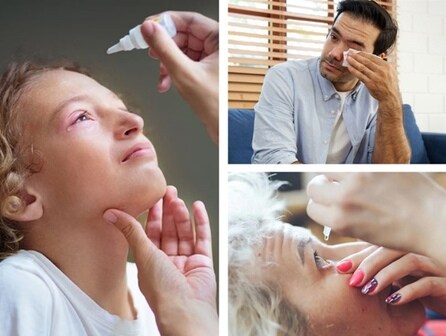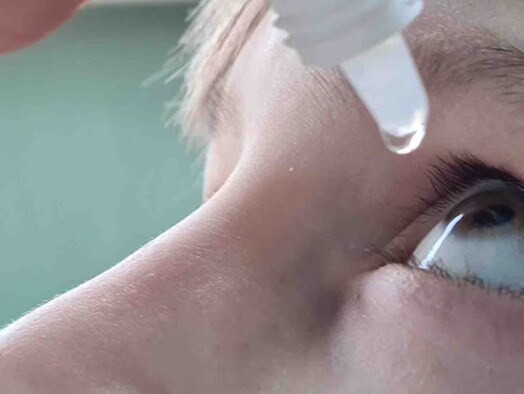Pink Eye Treatment Online | Walgreens
Online Pink Eye (Conjunctivitis) Treatment
Learn about pink eye symptoms, causes, and online treatment options with Walgreens Virtual Healthcare.
Available in select states*

Pink Eye (Conjunctivitis)
- What is conjunctivitis (pink eye)? 1-3
Conjunctivitis is inflammation of the inner clear layer of the eye called the conjunctiva and can affect one or both of the eyes. It is commonly called “pink eye” because it can cause the whites of the eye to turn red or pink due to inflammation and irritation. Pink eye has several different causes and often resolves on its own without medications in one to two weeks, but in some cases, medications may be needed. Pink eye can be caused by bacteria, viruses, allergens or irritants such as chemical fumes, contact lens wear, or foreign objects in the eye. Bacterial and viral pink eye are both contagious, and precautions should be taken to prevent the spread to others. It can be difficult to tell what has caused pink eye as symptoms of different types of pink eye can be similar. A healthcare provider can help determine what type of pink eye you have and discuss with you the appropriate treatments for infection and symptom relief.
- What are pink eye symptoms? 4-5
Some of the most common symptoms of pink eye include eye redness, swelling, watery eyes, itching and discomfort. These symptoms can affect one or both eyes. Depending on the cause of pink eye, you may experience additional symptoms.
- Bacterial pink eye symptoms can also include:
- Eye discharge, which is usually thick and can cause crusty eyes, sometimes leading to eyelids being stuck together upon waking
- Ear infection can also be present, with ear pain and drainage
- Viral pink eye symptoms can also include:
- Thin, watery eye discharge
- Usually begins in one eye and spreads to the other within several days
- Upper respiratory infections such as the cold or flu can also be present, along with their associated symptoms
- Allergic pink eye symptoms typically include:
- Eyes that are teary and swollen
- Intense eye itching
- Both eyes are typically affected
- May experience other allergic symptoms such as sneezing, congestion or itchy nose
- Irritant pink eye symptoms typically include:
- Watery eyes
- Eye discomfort
- Mucus discharge can occur, depending on the irritant
It may be difficult to differentiate the specific cause of pink eye, as symptoms of viral, bacterial, allergic and irritant pink eye may be very similar or overlap. Seeking medical care is important to determine the cause of your symptoms and if treatment is necessary.
- Bacterial pink eye symptoms can also include:
- What are the available pink eye treatments? 1,6-10
Pink eye that is caused by viruses or bacteria is very contagious. To help prevent the spread to others, it is important to wash your hands with soap and water often, avoid touching or rubbing your eyes, wash sheets and towels with hot water after use, and do not share any items such as towels, pillowcases or eye makeup.
Treatment for pink eye varies, depending on the cause:
- Most cases of bacterial pink eye are mild and get better without any medication. Mild cases may resolve in 2 to 5 days without treatment but could take up to 2 weeks to completely go away. However, if your symptoms are more severe or persist, a provider may prescribe antibiotic eye drops or eye ointments for bacterial pink eye. Antibiotics may help to shorten the length and severity of the infection. Bacterial pink eye is very contagious, and antibiotics help prevent the spread to others, which can be helpful when in daycare, school or work environments.
Antibiotics may be prescribed if:- Eye irritation occurs with pus
- You have a weakened immune system
- Certain bacteria are suspected
- You are a contact lens wearer
- When pink eye is caused by a virus, it can often be treated at home by applying a cool compress and using artificial tears to help relieve some of the inflammation and dry eye feelings. Viral pink eye will usually resolve on its own without treatment in one to two weeks. For symptom relief, over-the-counter (OTC) eye drops containing antihistamines or mast cell stabilizers (a group of medications that reduce allergy symptoms) may be recommended. In rare cases, an antiviral medication may be prescribed, for example when caused by the herpes simplex virus.
- When pink eye is caused by an allergen such as pet dander or pollen, it usually improves when the allergen is removed from your environment. At-home remedies such as applying a cool compress can also help. Sometimes, prescription and OTC eye drops and ointments can be used. Medications such as vasoconstrictors (which help reduce eye redness and inflammation), antihistamines and mast cell stabilizers can help relieve symptoms that occur from allergic pink eye. In some cases, your provider may recommend other allergy medications to improve symptoms.
- If an irritant such as chemical fumes or foreign objects like an eyelash is the cause of pink eye, removing the irritant is the first step in treatment. If it is a chemical, it is often recommended to flush the eyes with water and seek medical attention. Always seek medical attention if vision is affected.
When using any eye medication, be very careful not to touch the tip of the eye dropper or ointment tube to any surface, especially your hands or your eye to ensure the medication inside the container stays sterile. Discard the eye medication after completing your course of therapy to avoid spreading the germs to yourself or others. If you wear contact lenses, you should not wear them until your treatment is complete, symptoms have fully resolved, or until your eye doctor indicates it is safe to use again. Also, replace any eye makeup that you used before pink eye occurred, to prevent potential re-infection.
- Most cases of bacterial pink eye are mild and get better without any medication. Mild cases may resolve in 2 to 5 days without treatment but could take up to 2 weeks to completely go away. However, if your symptoms are more severe or persist, a provider may prescribe antibiotic eye drops or eye ointments for bacterial pink eye. Antibiotics may help to shorten the length and severity of the infection. Bacterial pink eye is very contagious, and antibiotics help prevent the spread to others, which can be helpful when in daycare, school or work environments.
- What are side effects of prescription pink eye drops? 8,11-20
All medications have potential side effects, including eye drops and ointments for pink eye. Side effects are different depending on the type of medication you are using.
- Common side effects of prescription antibiotic eye drops and ointments used to treat bacterial pink eye include minor eye irritations such as redness, burning, stinging, discomfort or itching. This may occur as soon as drops are placed in the eye or at any time with extended use and typically resolve when the eye drops are discontinued. Eye ointments can cause temporary blurred vision as the ointment slowly absorbs. As with all antibiotic medications, extended use may result in overgrowth of organisms that can no longer be killed by the antibiotic (called antibiotic resistance), including fungi. To prevent this and other complications, only use antibiotic eye drops and ointments as directed by your provider and for the duration instructed.
- Viral pink eye typically resolves on its own without the need for medication. However, in the rare case of viral pink eye due to herpes simplex virus or shingles, prescription eye drops or ointments may be recommended. Side effects of these medications may include temporary blurred vision (ointment or gel formulations), eye irritation, redness of the eye, mild temporary burning or stinging when first applying the medication, swelling of the eyelid and a rare eye condition called punctate keratitis (a condition of the eye caused by the death of small groups of cells on the surface of the eye, with symptoms of red watery eyes, sensitivity to light, possible bluffed vision; often a feeling as if a foreign object is in the eye).
- Prescription medications used to treat the symptoms of allergic pink eye include antihistamines and mast cell stabilizers. Mast cell stabilizers are medications that help reduce allergy eye symptoms such as itchy, watery and swollen red eyes. Common side effects from these medications include temporary eye burning, stinging and irritation, headaches, bitter taste and viral upper respiratory tract infection. These side effects are usually mild and resolve once medication is stopped.
More serious but rare side effects of any prescription eye drop or ointment can include hypersensitivity or allergic reactions, inflammation of the cornea, swelling of the area around the eye or face, sensation that a foreign object is in your eye, sensitivity to light, blurred vision, tearing, dryness, eye pain, nausea and dizziness. Seek medical help immediately if any of these symptoms occur.
- Are prescription pink eye drops safe for kids?
Some prescription eye drops and ointments are safe for children. However, every medication has its own FDA approved indication, including age of patient, safety profile and clinical studies conducted at certain pediatric ages. Speak with your child’s healthcare provider about which medication is safe for them to use.
- How to get pink eye treatments through Walgreens Virtual Healthcare?
During your Walgreens Virtual Healthcare visit, you will start by completing an online questionnaire. In this intake form you will answer questions about your current symptoms and provide details regarding your medication and health history. You will also be asked to provide close-up photos of each eye. A doctor or nurse practitioner will connect with you via secure online chat, and if appropriate, prescribe medication. A virtual visit is not appropriate if you wear contact lenses, have sudden onset vision loss, severe eye pain or recent trauma to the eye or are currently pregnant or breastfeeding, and you should seek an in-person provider instead.
Stay on track with Rx alerts & expert care
Frequently Asked Questions
- Can pink eye be diagnosed and treated virtually?
In some cases, yes. During a Walgreens Virtual Healthcare visit, a provider will evaluate your current symptoms, including when they started, how severe they are, and if you have tried any at-home remedies to resolve. They will also look at pictures of your eyes that you uploaded. The provider can determine if the likely cause of your pink eye is bacterial, viral or allergic, and if appropriate, the provider will send a prescription for a medication to your local Walgreens pharmacy or pharmacy of your choice.
For your safety, however, if you wear contact lenses, have severe eye pain, sudden onset vision changes or loss, recent trauma to the eye or are currently pregnant or breastfeeding, you will be referred to seek an in-person provider for an evaluation instead.
- Prescription pink eye drops vs. over-the-counter drops: What’s the difference? 6
For mild cases of pink eye, over the counter (OTC) treatment options can provide relief. These medications, such as antihistamines and artificial tears help treat the symptoms of dry eye, itchy eyes, eye irritation and redness.
Some prescription products contain medications in the same drug class as over-the-counter products, such as antihistamines, but are stronger or are in combination with other medications. If your pink eye is due to bacteria, prescription antibiotic eye drops and ointments may help relieve symptoms faster and shorten the contagious period.
If you are unsure if you need prescription eye drops or if OTC eye drops will work for you, speak with a healthcare provider to discuss your current symptoms.
- When should I see a doctor for pink eye? 2,6,21-22
If your pink eye symptoms get worse or do not go away, or if you have a weakened immune system, you should see a healthcare provider. They may need to prescribe an antibiotic or other treatment to help treat the infection. Some symptoms that require medical attention include worsening or severe eye pain, changes in vision, headache, swelling of eyelid or skin surrounding eye, symptoms lasting longer than a few days and light sensitivity. Symptoms that involve the eye can be serious and should be evaluated by a healthcare provider to avoid possible loss of vision or other complications. For example, it is possible for herpes zoster (shingles) to spread to the eye and cause visual disturbances or loss. With bacterial pink eye, seeking treatment may shorten the length of infection and allow you or your child to return to work, school and other activities sooner.
- What insurance does Walgreens Virtual Healthcare accept?
Currently, Walgreens Virtual Healthcare does not accept insurance. The cost of a pink eye visit is $33. Insurance, however, can help pay for many medications, including those prescribed to treat pink eye. Please speak with your insurance company or pharmacy about any questions you may have regarding your prescription drug coverage. The cost of medication is not included in the cost of your Walgreens Virtual Healthcare visit.
- What causes pink eye? 2-3,21-25
Pink eye can be due to various causes, including bacteria, viruses, allergens or irritants and is categorized based on what caused the pink eye. It can also occur as a symptom of certain conditions like COVID-19 or the flu. Rare causes of pink eye can include fungus, parasites, and foreign objects. Viral pink eye is the most common type, which is responsible for about 80% of all pink eye cases. Bacterial and viral pink eye can spread to your eyes by touching infected surfaces or sharing certain items like towels.
- Bacterial pink eye is often caused by bacteria such as Staphylococcus pneumoniae, Staphylococcus aureus, Haemophilus influenza, and Moraxella catarrhalis, and more commonly occurs in children. Interestingly, bacterial pink eye is more common during the months of December through April.
- Viral pink eye, which happens more frequently in adults is commonly caused by adenovirus. Viral pink eye can be a symptom of a systemic viral infection, which usually resolves on its own. In some cases, such as a shingles or chickenpox infection, you may be at risk for complications if symptoms occur near or in your eye.
- Allergic pink eye may happen seasonally or during certain times of exposure to allergens. Your body can mistake certain substances in the environment (allergens) as a threat and therefore respond with allergy symptoms such as itchy, red eyes. Common allergens may include pollen, dander, dust, and molds.
- Certain chemicals can cause your eyes to become irritated due to harshness, leading to irritant or chemical pink eye. For example, chemicals such as chlorine in a pool can cause your eyes to become watery and red. Other irritants may include smoke, chemicals in cleaning products, and extended contact lens use.
- Is pink eye contagious? 22,24
Pink eye can be very contagious, depending on its cause. Bacterial and viral pink eye can easily spread to others, while allergen and chemical or irritant pink eye cannot. If you happen to have bacterial or viral pink eye, it is sometimes recommended to stay home from work or school to prevent spreading it to other, however check your specific facility for their policy. If you are experiencing pink eye symptoms, it is important to prevent infection to others by washing your hands, frequently washing towels and linens with hot water, not sharing personal items such as pillows, makeup and other items that touch your eyes or face. Refrain from touching your eyes, but if you do, wash your hand immediately.
While most cases of pink eye resolve on their own without medication within days or weeks, the contagious period bacterial pink eye may be shortened with antibiotic treatment. This may allow you or your child to be able to return to work or school sooner after starting treatment.
- How prescription pink eye drops work 6,8,11-19,26-27
Prescription medications for pink eye work in different ways depending on what type of pink eye they are trying to treat.
- Antibiotic eye drops and ointments prescribed for bacterial pink eye work by killing the bacteria that is causing the infection. These medications help to shorten the length of infection, prevent the spread to others, and help reduce complications.
- Medications prescribed for viral pink eye are simlar to those that treat bacterial pink eye. They kill the virus (instead of the bacteria) that is causing the eye infection.
- Prescription medications used to treat the symptoms of allergic pink eye include mast cell stabilizers and antihistamines. When exposed to an allergen, cell in our bodies called mast cells release histamine. Histamine is a chemical in our body that causes the symptoms of allergic pink eye, such as itchy, watery and swollen red eyes. Mast cell stabilizer medications prevent mast cells from releasing histamine. Antihistamine medications block the effects of histamine. Both medications work to prevent or lessen the symptoms of allergic pink eye.
Speak with your healthcare provider about your symptoms and they can help determine if a pink eye treatment is right for you, and if so, which one.
References
- Boyd K. Conjunctivitis: What is pink eye? American Academy of Ophthalmology. May 14, 2025. Accessed June 19, 2025. https://www.aao.org/eye-health/diseases/pink-eye-conjunctivitis
- U.S. National Library of Medicine. Conjunctivitis or Pink Eye. MedlinePlus. July 9, 2024. Accessed June 17, 2025. https://medlineplus.gov/ency/article/001010.htm
- Pink eye: Causes and how it spreads. Centers for Disease Control and Prevention. April 15, 2024. Accessed June 17, 2025. https://www.cdc.gov/conjunctivitis/causes/index.html
- Symptoms of pink eye. Centers for Disease Control and Prevention. April 15, 2024. Accessed June 17, 2025. https://www.cdc.gov/conjunctivitis/signs-symptoms/index.html
- Types of bacterial conjunctivitis. Centers for Disease Control and Prevention. April 24, 2024. Accessed June 18, 2025. https://www.cdc.gov/conjunctivitis/hcp/clinical-overview/bacterial-types.html
- How to treat Pink Eye. Centers for Disease Control and Prevention. April 15, 2024. Accessed June 18, 2025. https://www.cdc.gov/conjunctivitis/treatment/index.html
- Naphcon A. Package insert. Alcon. 2022. https://www.accessdata.fda.gov/drugsatfda_docs/label/2022/020226Orig1s035lbl.pdf
- Optivar. Package insert. Meda Pharmaceuticals Inc. 2008. https://www.accessdata.fda.gov/drugsatfda_docs/label/2008/021127s013lbl.pdf
- Cromolyn Sodium ophthalmic solution, USP 4%. Package insert. Valeant Pharmaceuticals North America LLC. 2016. https://pi.bausch.com/globalassets/pdf/PackageInserts/Pharma/Rx-Generics/Cromolyn-Sodium-package-insert.pdf
- Pink eye (conjunctivitis). Cleveland Clinic. April 17, 2024. Accessed June 18, 2025. https://my.clevelandclinic.org/health/diseases/pink-eye-conjunctivitis
- Erythromycin ointment. Package insert. Fera Pharmaceuticals LLC and Steri-Med Pharma Inc. 2023. dailymed.nlm.nih.gov/dailymed/fda/fdaDrugXsl.cfm?setid=be59bb85-8ef4-4f9e-85e5-c05662ecd1ee&type=display
- Polymixin B Sulfate and Trimethoprim Opthamalic Solution, USP Sterile. Package insert. Sandoz Inc. 2021. https://www.accessdata.fda.gov/spl/data/85cac791-8812-41fb-8809-8c64bfc6214c/85cac791-8812-41fb-8809-8c64bfc6214c.xml
- Ocuflox. Package insert. Allergan Inc. 2016. https://www.accessdata.fda.gov/drugsatfda_docs/label/2016/019921s021lbl.pdf
- Bacitracin Polymixin B. Package insert. Bausch & Lomb Inc. 2023. https://www.drugs.com/pro/bacitracin-polymyxin-b.html
- Ciloxan. Package insert. Alcon. 2016. https://www.accessdata.fda.gov/drugsatfda_docs/label/2017/019992s026lbl.pdf
- Viroptic. Package insert. Pfizer. 2025. labeling.pfizer.com/ShowLabeling.aspx?id=700
- Zirgan. Package insert. Sirion Therapeutics Inc. 2009. https://www.accessdata.fda.gov/drugsatfda_docs/label/2009/022211lbl.pdf
- Bepreve. Package insert. Bausch & Lomb Inc. 2009. https://www.accessdata.fda.gov/drugsatfda_docs/label/2009/022288lbl.pdf
- Cromolyn sodium ophthalmic solution, USP 4% (sterile). Package insert. Bausch & Lomb Inc. 2016. https://pi.bausch.com/globalassets/pdf/PackageInserts/Pharma/Rx-Generics/Cromolyn-Sodium-package-insert.pdf
- Superficial punctate keratitis. Merck Manual Consumer Version. July 2024. Accessed June 18, 2025. https://www.merckmanuals.com/home/eye-disorders/corneal-disorders/superficial-punctate-keratitis
- Shingles symptoms and complications. Centers for Disease Control and Prevention. April 19, 2024. Accessed June 18, 2025. https://www.cdc.gov/shingles/signs-symptoms/index.html
- Clinical overview of Pink Eye (conjunctivitis). Centers for Disease Control and Prevention. April 15, 2024. Accessed June 17, 2025. https://www.cdc.gov/conjunctivitis/hcp/clinical-overview/index.html
- Hashmi MF, Gurnani B, Benson S. Conjunctivitis. StatPearls. January 26, 2024. Accessed June 17, 2025. https://www.ncbi.nlm.nih.gov/books/NBK541034/
- How to prevent Pink Eye. Centers for Disease Control and Prevention. April 15, 2024. Accessed June 17, 2025. https://www.cdc.gov/conjunctivitis/prevention/index.html
- Preventing eye irritation from pool chemicals. Centers for Disease Control and Prevention. May 28, 2025. Accessed June 18, 2025. https://www.cdc.gov/healthy-swimming/prevention/preventing-eye-irritation-from-pool-chemicals.html
- Histamine. Cleveland Clinic. March 28, 2023. Accessed June 11, 2025. https://my.clevelandclinic.org/health/articles/24854-histamine
- Mast Cells. Cleveland Clinic. May 16, 2024. Accessed June 11, 2025. https://my.clevelandclinic.org/health/body/mast-cells
Disclaimers
*Currently available in the following states: AL, AZ, CA, CO, CT, FL, GA, IL, IN, KS, KY, LA, MA, MD, MI, MN, MO, NC, NJ, NV, NY, OH, OK, PA, SC, TN, TX, VA, WA, WI
Based on national averages. Actual times may vary.
Labcorp and Quest staff are not associates, employees and/or agents of Walgreen Co. or any Walgreens subsidiary or affiliated company. Lab service will be a separate fee, price may vary.
Prescription based on medical evaluation and not guaranteed.
Walgreens-affiliated medical practices are independently owned and operated by licensed physicians who provide services using the Walgreens virtual care program telehealth platform. For more information about the relationship between Walgreens and the medical practices click here.
Walgreens Health Medical Group California P.C. is a California professional medical corporation utilizing the fictitious name “Walgreens Health Medical Group California P.C.” pursuant to Cal. Bus. & Prof. Code § 2415. To view the Fictitious Name Permit click here.






